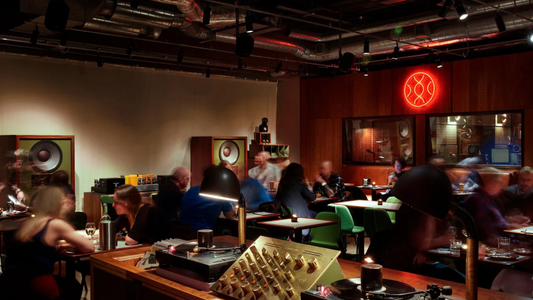
Two Drinks, Two Songs: Blue on Velvet’s Quiet Ritual
By Rafi Mercer
New Listing
Blue on Velvet is one of Koenji’s intimate upstairs listening bars — explore more in our Tokyo Music Venues guide.
Venue Details:
Venue Name: Blue on Velvet
Address: 3 Chome-59-8 Koenjiminami, Suginami City, Tokyo 166-0003, Japan
Website: Not available
Phone: Not available
Spotify Profile: Not available
Koenji is a neighbourhood that hums with defiance. Long favoured by punks, second-hand record diggers, and seekers of the alternative, it has held onto a bohemian edge even as Tokyo’s mainstream districts become ever more polished. It’s here, hidden above a quiet stretch of street, that you find Blue on Velvet — a listening bar so intimate that it feels more like someone’s living room than a commercial establishment. A narrow staircase leads you upward, past posters of Japanese rock bands and fading flyers from long-past gigs, until you reach the door. Push it open and you are greeted not by neon or spectacle, but by the comforting clutter of music in physical form: records stacked, CDs lined, speakers positioned with care rather than decoration.
The system at Blue on Velvet is modest compared to the lavish Tannoy setups elsewhere in Tokyo, but it is clearly chosen with love. A pair of speakers, vintage and warm, fill the room with a sound that is more embracing than analytical. It doesn’t dissect the music so much as enfold you within it. And the library is the true star: a sprawling personal collection that reaches deep into Japanese rock and Western music of the 1970s through the 1990s. Here, you’ll find battered LPs of Lou Reed rubbing shoulders with pristine city pop, psychedelic experiments alongside shoegaze obscurities.
There is a ritual at the heart of Blue on Velvet, one that defines the character of the room. For each drink you order, you are invited to request two songs from the collection. The bartender — a figure equal parts host, curator, and confidant — will select your chosen discs, place them on the turntable or into the CD player, and let them fill the room. It is a simple rule, but one that changes the dynamic entirely. Instead of a top-down curation where patrons passively absorb the selector’s taste, here there is a conversation between collection and community. You drink, you listen, you request, you share. Music becomes an exchange rather than a broadcast.
The effect is communal, binding. A stranger’s request can spark recognition, a head turned in surprise, a smile of acknowledgement. Suddenly you are listening together, experiencing the joy of discovery not in solitude but in solidarity. In an age where algorithms serve us songs tailored to our private histories, there is something deeply moving about hearing another person’s choices — to sit in a room and discover what matters to them, what track they needed in that moment.
The acoustic environment is unpretentious. The room is small, with bare walls softened by shelves of records. Sound reflects, settles, and occasionally muddles, but in a way that feels part of the experience rather than a flaw. This is not a space designed to showcase pristine fidelity; it is a space designed to showcase taste, memory, and the joy of playing records aloud. The imperfections are part of the charm, the audible equivalent of the scuffed wooden counter where your glass rests.
Koenji itself provides context. This is a neighbourhood that still values the analogue: second-hand clothing, indie live houses, underground record shops. Blue on Velvet feels like a natural extension of that ethos — a bar that doesn’t need polish or prestige because it has personality. Walk in on a Friday night and you may find a cluster of regulars swapping stories about the first time they saw Sonic Youth. Walk in on a Tuesday and you may be the only one, listening in near solitude to a record you never thought you’d hear in public again.
Consistency here is measured differently than in Ginza or Shibuya’s high-end bars. At Blue on Velvet, it is not about guaranteeing a certain level of acoustic perfection or mixology elegance. It is about ensuring that the ritual — the exchange of drink for request — holds firm, that the room remains a safe space for music lovers, that the collection is alive and available. And on those terms, Blue on Velvet delivers, week after week.
What makes the bar powerful is its scale. In larger venues, you are often a body in the crowd. Here, you are a participant. Your choices matter. Your presence shifts the evening. In that sense, Blue on Velvet is less a bar and more a collective improvisation. Each night is unique, authored partly by the bartender and partly by whoever walks in. And when you leave, you do so with the knowledge that the soundtrack you heard will never be repeated in exactly that form again.
There is poetry in the bar’s name. Velvet suggests smoothness, luxury, texture. Blue suggests melancholy, music, depth. Together they frame the experience: textured, melancholic, musical. It is not a bar for spectacle or for trend-chasing Instagram shots. It is a bar for those who find comfort in the act of choosing a song, of hearing it fill a room, of knowing that someone else is listening with you.
If there are flaws, they are of scale and ambition. The system, while warm, cannot rival the precision of Tokyo’s audiophile temples. The drinks, while good, are simple. The space, while cosy, can feel cramped when full. Yet to critique Blue on Velvet on these grounds is to miss its point. It does not aspire to be a temple. It aspires to be a room where music matters. And in that, it succeeds wholly.
Perhaps the greatest compliment you can give Blue on Velvet is this: after a night there, you leave not only with songs in your head, but with a renewed appreciation for music as a shared language. You leave humming someone else’s choice, perhaps one you had never heard before. And that is the kind of listening experience that lingers far beyond the last note.
Explore More
See our Listening Bar Collection
Rafi Mercer writes about the spaces where music matters. For more stories from Tracks & Tales, subscribe or click here to read more.







